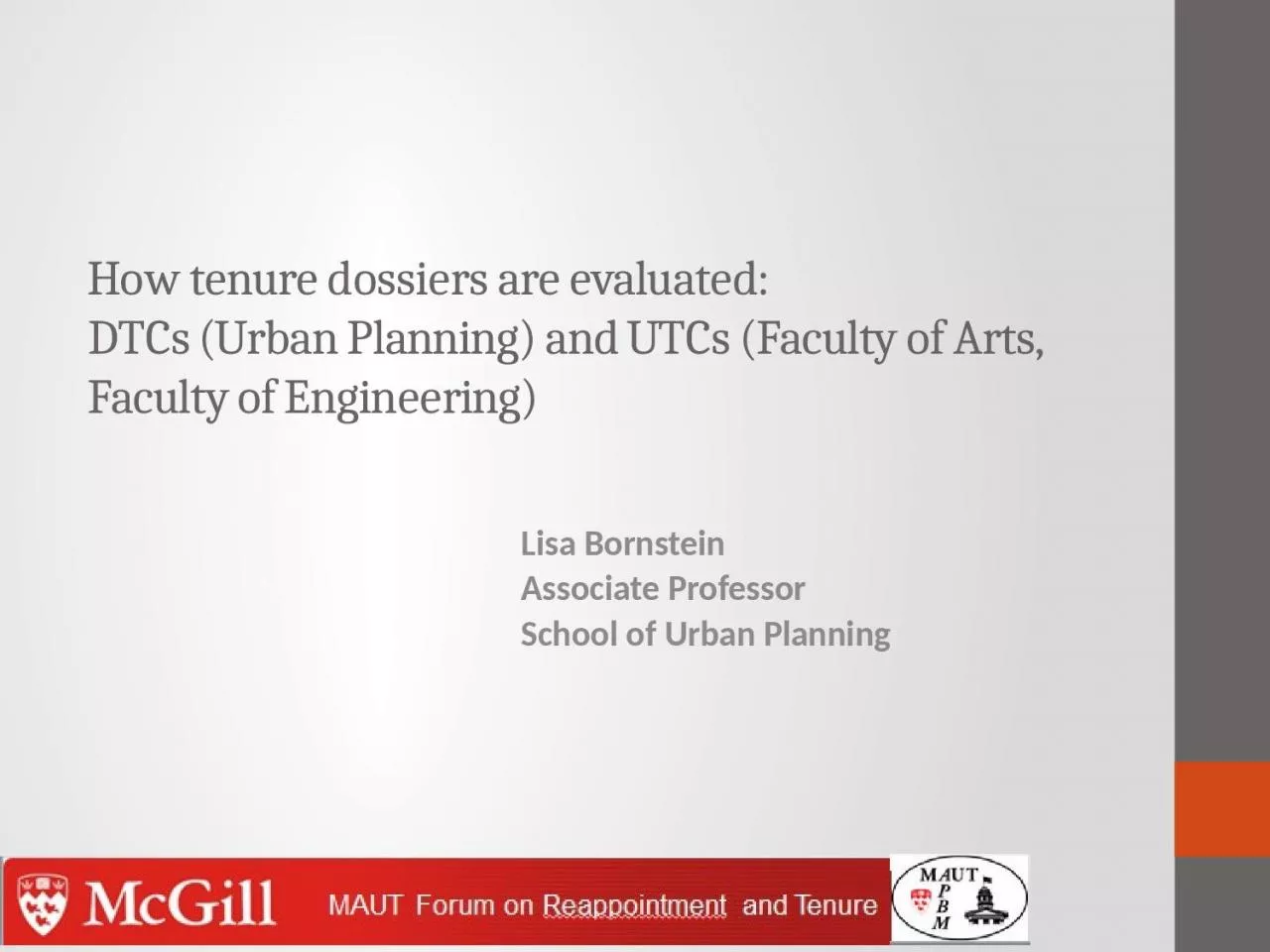

evaluated DTCs Urban Planning and UTCs Faculty of Arts Faculty of Engineering Lisa Bornstein Associate Professor School of Urban Planning My experience Own tenure process in Urban Planning Faculty of Engineering ID: 1046166
Download Presentation The PPT/PDF document "How tenure dossiers are" is the property of its rightful owner. Permission is granted to download and print the materials on this web site for personal, non-commercial use only, and to display it on your personal computer provided you do not modify the materials and that you retain all copyright notices contained in the materials. By downloading content from our website, you accept the terms of this agreement.
1. How tenure dossiers are evaluated: DTCs (Urban Planning) and UTCs (Faculty of Arts, Faculty of Engineering)Lisa BornsteinAssociate ProfessorSchool of Urban Planning
2. My experienceOwn tenure process in Urban Planning, Faculty of EngineeringDTCs: School of Urban PlanningUTC: Faculty of Arts, 2 yearsUTC: Faculty of Engineering, 2 yearsPresentation by Ghyslaine McClure, Civ Eng (2012)
3. Criteria for tenureDemonstrated evidence of successful performance Meeting the criteria expected of your reference group(s)Excellence in at least two of the three areas (research, teaching, service) with at least satisfactory performance in the third Most candidates (approx. 85-90%) at McGill are successful
4. PitfallsWeak response to DTC/UTC ‘tending to a negative’Poorly prepared presentation and supplementary material MAUT can help. But talk to others & practice as well!Poorly prepared dossierSloppy, wordy, disorganized, repetitiveResearch areas and contributions unclearTeaching and supervision unclear or inaccuratePresentation of service perfunctory Negative assessmentsLetters from external evaluatorsPoor relations with/reports from those in your unitProblem issues identified at reappointment or in teaching evaluations and left unaddressed!
5. The tenure dossierPrepare:Find out the current and specific tenure criteria of your discipline (find a mentor!)Choose your external reviewers cautiouslyIf there are problems, address themProvide clear evidence of your superior performance Prepare high-quality, readable documents style, format and tone matter (time consuming – start early)write for your audience (avoid jargon, equations, and the like)be conciseavoid double counting (be strategic…)review and have others review your document
6. The DTCAssess research, teaching and service (dossier + external letters)Have a clear idea of criteria for the specific field May have insight into the ‘quality of performance’ via direct observations and involvement‘Fit with the unit’ and ‘contribution to the unit’ImprovementCan explain ‘anomalies’ in DTC reportteaching & committee load, doctoral students, publication route, priorities of unit Not always positive in assessmentOpportunity for you to supplement & clarify dossier
7. The UTCChaired by Dean of the FacultyMulti-disciplinary compositionFundamentally on your sideAssess research, teaching and service dossier + external letters + DTC report + any additional material from a ‘tending to a negative’ proces)Standards of unit + demonstrated performance (not potential)Recognition of variations across and within fieldsWider definitions of contribution (e.g., inter-disciplinarity)‘Tending to negative’ letter is an opportunity for you to respond to concerns
8. For superior performance in researchCriteria vary in different disciplinesQuantity and quality of publicationsTarget number of publications Impact factors (?) – use if helpful to your casePublication routes & authorship conventions vary – explain yours if it is atypicalDevelopment of an independent research agendaContribution to the field(s)Recognition in your field(s): invited talks, citationsCanadian grants, at least one as PIin Engineering: NSERC Discovery Grant, FQRNT New Researcher Grant, other NSERC, FQRNT, SSHRC, FQRSCEvidence of mentorship and/or collaborationApplied, professional, ‘artistic’ research 8
9. For superior performance in teachingTeaching load and course evaluation scoresmake the best analysis possible; check specific scores (e.g., “I learned a lot in this course”); point out improvement and/or measures taken to address weaknesses; explain anomalies Show curriculum development, innovative methodsGraduate student supervision and co-supervision Numbers, progress of students, mentorship (co-authorship or conference presentation)Other training, teaching, supervision, mentorship activitiesTry to make sure you have graduated a few PhDs. If hasn’t happened, explain as positively as possible9
10. For superior performance in serviceService defined in different ways in the Faculty (& elsewhere) University committeesQuality of service more important than quantity hereMembership in professional associationOutstanding service will not compensate for reasonable research or poor teaching but does count!10Typical valued activities: Contributions to the academic community e.g., reviews for journals; PhD examination committees outside your unit; active membership in technical associations (local, Canadian & international); organisation of conference sessionsContributions to or engagement with the external ‘lay’ community (government, community, professionals, ‘industry’)
11. Thank you (and good luck!)